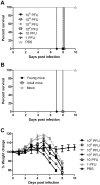Characterization of Lethal Zika Virus Infection in AG129 Mice
- PMID: 27093158
- PMCID: PMC4836712
- DOI: 10.1371/journal.pntd.0004682
Characterization of Lethal Zika Virus Infection in AG129 Mice
Erratum in
-
Correction: Characterization of Lethal Zika Virus Infection in AG129 Mice.PLoS Negl Trop Dis. 2016 May 23;10(5):e0004750. doi: 10.1371/journal.pntd.0004750. eCollection 2016 May. PLoS Negl Trop Dis. 2016. PMID: 27214379 Free PMC article.
Abstract
Background: Mosquito-borne Zika virus (ZIKV) typically causes a mild and self-limiting illness known as Zika fever, which often is accompanied by maculopapular rash, headache, and myalgia. During the current outbreak in South America, ZIKV infection during pregnancy has been hypothesized to cause microcephaly and other diseases. The detection of ZIKV in fetal brain tissue supports this hypothesis. Because human infections with ZIKV historically have remained sporadic and, until recently, have been limited to small-scale epidemics, neither the disease caused by ZIKV nor the molecular determinants of virulence and/or pathogenicity have been well characterized. Here, we describe a small animal model for wild-type ZIKV of the Asian lineage.
Methodology/principal findings: Using mice deficient in interferon α/β and Ɣ receptors (AG129 mice), we report that these animals were highly susceptible to ZIKV infection and disease, succumbing within seven to eight days. Rapid viremic dissemination was observed in visceral organs and brain; but only was associated with severe pathologies in the brain and muscle. Finally, these results were consistent across challenge routes, age of mice, and inoculum doses. These data represent a mouse model for ZIKV that is not dependent on adapting ZIKV to intracerebral passage in mice.
Conclusions/significance: Foot pad injection of AG129 mice with ZIKV represents a biologically relevant model for studying ZIKV infection and disease development following wild-type virus inoculation without the requirement for adaptation of the virus or intracerebral delivery of the virus. This newly developed Zika disease model can be exploited to identify determinants of ZIKV virulence and reveal molecular mechanisms that control the virus-host interaction, providing a framework for rational design of acute phase therapeutics and for vaccine efficacy testing.
Conflict of interest statement
The authors have declared that no competing interests exist.
Figures





Similar articles
-
Fetal Brain Infection Is Not a Unique Characteristic of Brazilian Zika Viruses.Viruses. 2018 Oct 3;10(10):541. doi: 10.3390/v10100541. Viruses. 2018. PMID: 30282919 Free PMC article.
-
Zika Virus Targeting in the Developing Brain.J Neurosci. 2017 Feb 22;37(8):2161-2175. doi: 10.1523/JNEUROSCI.3124-16.2017. Epub 2017 Jan 25. J Neurosci. 2017. PMID: 28123079 Free PMC article.
-
ICR suckling mouse model of Zika virus infection for disease modeling and drug validation.PLoS Negl Trop Dis. 2018 Oct 24;12(10):e0006848. doi: 10.1371/journal.pntd.0006848. eCollection 2018 Oct. PLoS Negl Trop Dis. 2018. PMID: 30356305 Free PMC article.
-
Zika infection and the development of neurological defects.Cell Microbiol. 2017 Jun;19(6). doi: 10.1111/cmi.12744. Epub 2017 May 3. Cell Microbiol. 2017. PMID: 28370966 Review.
-
Testing for Zika virus infection in pregnancy: key concepts to deal with an emerging epidemic.Am J Obstet Gynecol. 2017 Mar;216(3):209-225. doi: 10.1016/j.ajog.2017.01.020. Epub 2017 Jan 23. Am J Obstet Gynecol. 2017. PMID: 28126366 Review.
Cited by
-
Differential cell line susceptibility to the emerging Zika virus: implications for disease pathogenesis, non-vector-borne human transmission and animal reservoirs.Emerg Microbes Infect. 2016 Aug 24;5(8):e93. doi: 10.1038/emi.2016.99. Emerg Microbes Infect. 2016. PMID: 27553173 Free PMC article.
-
Emerging and reemerging infectious diseases: global trends and new strategies for their prevention and control.Signal Transduct Target Ther. 2024 Sep 11;9(1):223. doi: 10.1038/s41392-024-01917-x. Signal Transduct Target Ther. 2024. PMID: 39256346 Free PMC article. Review.
-
Zika virus infection and pregnancy: what we do and do not know.Pathog Glob Health. 2016 Oct-Dec;110(7-8):262-268. doi: 10.1080/20477724.2016.1234804. Epub 2016 Sep 30. Pathog Glob Health. 2016. PMID: 27690200 Free PMC article. Review.
-
Functional Genomics and Immunologic Tools: The Impact of Viral and Host Genetic Variations on the Outcome of Zika Virus Infection.Viruses. 2018 Aug 11;10(8):422. doi: 10.3390/v10080422. Viruses. 2018. PMID: 30103523 Free PMC article.
-
Research Models and Tools for the Identification of Antivirals and Therapeutics against Zika Virus Infection.Viruses. 2018 Oct 30;10(11):593. doi: 10.3390/v10110593. Viruses. 2018. PMID: 30380760 Free PMC article. Review.
References
Publication types
MeSH terms
Substances
Grants and funding
LinkOut - more resources
Full Text Sources
Other Literature Sources
Medical

